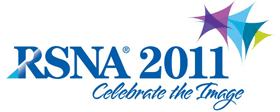
Abstract Archives of the RSNA, 2011
Deborah J Rhodes MD, Presenter: Nothing to Disclose
Carrie B. Hruska PhD, Abstract Co-Author: Institutional license agreement, Gamma Medica Ideas, Inc
Amy Lynn Conners MD, Abstract Co-Author: Nothing to Disclose
Cindy L. Tortorelli MD, Abstract Co-Author: Nothing to Disclose
Robert Maxwell MD, Abstract Co-Author: Nothing to Disclose
Michael K. O'Connor PhD, Abstract Co-Author: Research grant, General Electric Company
Patent royalties, Gamma Medica Ideas, Inc
We previously demonstrated that addition of Molecular Breast Imaging (MBI), following injection of 20 mCi Tc-99 m sestamibi, to screening mammography (MG) significantly increased detection of breast cancer in dense breasts from 27% with MG alone to 91% with the combination (p=0.016). After implementing modifications that permit radiation dose reduction, we are comparing performance of incident screen MG and prevalent screen low-dose MBI in 2400 women with dense breasts.
Women presenting for screening digital MG between June 2010 - March 2011 with heterogeneously or extremely dense breasts on past prior MG were enrolled and underwent screening MG and MBI. MBI was performed with 8 mCi injection of Tc-99m sestamibi and dual-head cadmium zinc telluride detectors and acquired in dynamic frames to allow generation of 4 mCi-equivalent images. Mammograms and MBIs were read independently by 2 different radiologists. MBIs were assigned an assessment score of 1-5 which parallels BI-RADs; scores of 3-5 on MBI were considered positive and led to diagnostic workup.
In 600 women studied to date, 9 cancers were diagnosed in 9 patients. MBI detected cancer in 8 of 9 (89%) and MG detected none.The remaining cancer was detected on prophylactic mastectomy (7 mm invasive lobular carcinoma). Mammographically occult cancers detected by MBI included: 3 DCIS; 1 tubular cancer; 2 invasive ductal carcinoma; and 2 invasive lobular carcinoma. Tumor size ranged from 6-41 mm; all but one tumor was node negative. A total of 106 women were recalled for diagnostic evaluation: 44 due to prevalent MBI alone; 58 due to incident MG alone; 4 due to both.Twenty-six women underwent biopsy: prompted by MBI alone in 22; by MG alone in 2; and by both in 1. PPV for MBI was 35% (8/23). All MBI-detected cancers were visible on the 4 mCi-equivalent images.
This interim analysis supports low-dose MBI as an adjunct and potential alternative to screening MG in women with dense breasts. Follow-up MG at one-year will be necessary to establish true sensitivity and specificity. Ongoing dose-reduction work will allow MBI screening to be performed with 4 mCi Tc-99m sestamibi, with effective dose comparable to screening MG.
With recent dose reduction modifications, low-dose MBI performed at 4 mCi is as or more sensitive than conventional-dose MBI (20—30 mCi) in detecting mammographically occult cancers in dense breasts.
Rhodes, D,
Hruska, C,
Conners, A,
Tortorelli, C,
Maxwell, R,
O'Connor, M,
Low-Dose Molecular Breast Imaging with Tc-99m Sestamibi for Screening in Women with Mammographically Dense Breasts . Radiological Society of North America 2011 Scientific Assembly and Annual Meeting, November 26 - December 2, 2011 ,Chicago IL.
http://archive.rsna.org/2011/11004819.html

